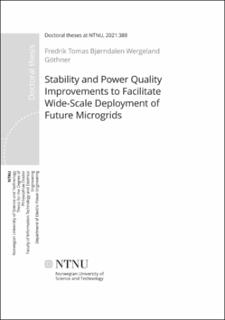| dc.contributor.advisor | Midtgård, Ole-Morten | |
| dc.contributor.author | Göthner, Fredrik Tomas Bjørndalen Wergeland | |
| dc.date.accessioned | 2024-01-02T12:04:55Z | |
| dc.date.available | 2024-01-02T12:04:55Z | |
| dc.date.issued | 2023 | |
| dc.identifier.isbn | 978-82-326-5358-4 | |
| dc.identifier.issn | 2703-8084 | |
| dc.identifier.uri | https://hdl.handle.net/11250/3109309 | |
| dc.description.abstract | The massive integration of distributed energy resources (DERs) represents a paradigm shift for the traditional power system, which until recently has been dominated by large, centralized power generation units. In addition to being located at lower voltage levels, DERs are typically smaller, intermittent, and interfaced by power electronic converters, thereby presenting substantially different characteristics to conventional synchronous generators. This creates new challenges and opportunities for the operation of power systems. An attractive alternative that has emerged over the past two decades as a response to this trend is the microgrid approach. Microgrids enable an organized implementation of distributed generators (DGs), various ancillary services to the grid, as well as improved reliability and resilience. Nonetheless, there are still pending issues related to the stability and power quality of such grids, particularly in scenarios with a large deployment of DGs. The objective of this work is to develop control strategies and models that target these issues, in order to obtain improved performance for future microgrids.
In particular, to address the stability issue from a system perspective, a centralized controller for improving the microgrid stability margins is proposed. The stability margins of such systems have been shown to be poor, particularly when DGs are located close to each other. Hence, this will likely become more challenging with increased DG deployment. The controller adaptively changes the droop controller gains of the DGs according to the location of the dominant modes in the system. The modes are estimated by using the apparent impedance method, which links impedance measurements with the eigenvalues of the corresponding system. The method does not rely on any information of the system topology or parameter values. It is shown that the proposed controller can greatly enhance the system stability margins while maintaining accurate active power sharing between DGs. In addition, the low communication requirements of the conventional droop control are maintained with the proposed controller. As such, this method enables microgrids with larger amounts of DGs.
To further study the stability of microgrids, a reduced-order model of a DG is also developed. Such models have gained interest in the technical literature for being less computationally expensive and simpler to analyze. Unlike most of the models in the literature, the developed model includes the dynamics of internal control loops and virtual impedances, while simultaneously achieving a low model order. However, reduced-order models are inherently a trade-o_ between simplicity and accuracy. Therefore, the validity of the model assumptions is investigated, and a method for choosing an appropriate model order is proposed. By using the model, differences between quasi-stationary and transient virtual impedances are shown. In particular, it is analytically demonstrated that the system stability region is larger when using the quasi-stationary virtual impedance.
Finally, a method for improving the power quality of microgrids is proposed. Power quality is an increasing concern for microgrids, due to the widespread use of nonlinear loads. This issue can be addressed by appropriate control of the DGs, such as by incorporating harmonic virtual impedances. However, there exists an inherent trade-off between voltage quality and current harmonic sharing among the DGs. To address this issue, an optimization algorithm is proposed to set the harmonic virtual impedances of DGs in a multibus microgrid. Improving the voltage quality is the main objective of the algorithm, while any degree of harmonic current sharing can be specified as a constraint. The algorithm is executed periodically to account for changes in the grid conditions. While communications are necessary for the functioning of the proposed method, these are not time-critical such that a low-bandwidth communication can be used.
Each of these applications is described in detail and placed in the context of the relevant state-of-the-art. The proposed control schemes and analytical models were validated through numerical simulations and experimental results. | en_US |
| dc.language.iso | eng | en_US |
| dc.publisher | NTNU | en_US |
| dc.relation.ispartofseries | Doctoral theses at NTNU;2021:388 | |
| dc.relation.haspart | Paper 1: Göthner, Fredrik T. B. W.; Torres Olguin, Raymundo E.; Roldan-Pérez, Javier; Rygg, Atle; Midtgård, Ole-Morten. Apparent Impedance-Based Adaptive Controller for Improved Stability of Droop-Controlled Microgrid. IEEE transactions on power electronics 2021 ;Volum 36.(8) s. 9465-9476. Copyright © 2021 IEEE. Available at: http://dx.doi.org/10.1109/TPEL.2021.3050615 | en_US |
| dc.relation.haspart | Paper 2: Göthner, Fredrik T. B. W.; Roldan-Pérez, Javier; Torres Olguin, Raymundo E.; Midtgård, Ole-Morten. Reduced-Order Model of Distributed Generators with Internal Loops and Virtual Impedance. IEEE Transactions on Smart Grid 2021 ;Volum 13.(1) s. 119-128. Copyright © 2021 IEEE. Available at: http://dx.doi.org/10.1109/TSG.2021.3120323 | en_US |
| dc.relation.haspart | Paper 3: Göthner, Fredrik T. B. W.; Roldan-Pérez, Javier; Torres Olguin, Raymundo E.; Midtgård, Ole-Morten.Harmonic Virtual Impedance Design for Optimal Management of Power Quality in Microgrids. IEEE transactions on power electronics 2021 ;Volum 36.(9) s. 10114-10126. Copyright © 2021 IEEE. Available at: http://dx.doi.org/10.1109/TPEL.2021.3065755 | en_US |
| dc.title | Stability and Power Quality Improvements to Facilitate Wide-Scale Deployment of Future Microgrids | en_US |
| dc.type | Doctoral thesis | en_US |
| dc.subject.nsi | VDP::Teknologi: 500::Elektrotekniske fag: 540::Elkraft: 542 | en_US |
